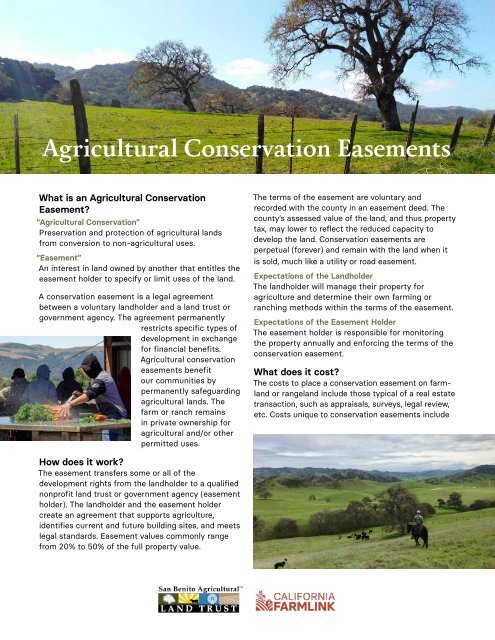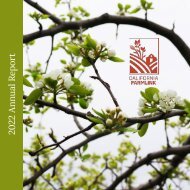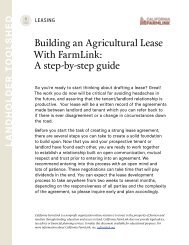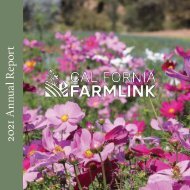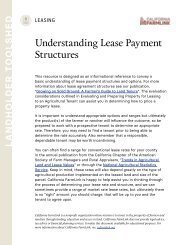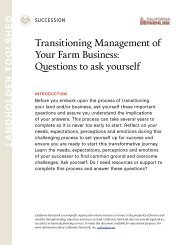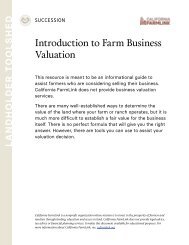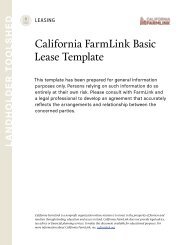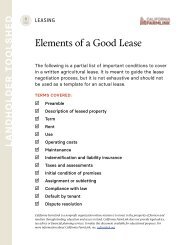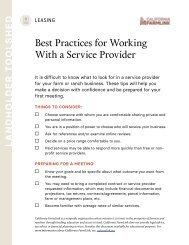Conservation Easement Handout- English (5.12.22)_DOC_acknowledgement
You also want an ePaper? Increase the reach of your titles
YUMPU automatically turns print PDFs into web optimized ePapers that Google loves.
Agricultural <strong>Conservation</strong> <strong>Easement</strong>s<br />
What is an Agricultural <strong>Conservation</strong><br />
<strong>Easement</strong>?<br />
“Agricultural <strong>Conservation</strong>”<br />
Preservation and protection of agricultural lands<br />
from conversion to non-agricultural uses.<br />
“<strong>Easement</strong>”<br />
An interest in land owned by another that entitles the<br />
easement holder to specify or limit uses of the land.<br />
A conservation easement is a legal agreement<br />
between a voluntary landholder and a land trust or<br />
government agency. The agreement permanently<br />
restricts specific types of<br />
development in exchange<br />
for financial bene fits.<br />
Agricultural conservation<br />
easements benefit<br />
our communities by<br />
permanently safeguarding<br />
agri cultural lands. The<br />
farm or ranch remains<br />
in private ownership for<br />
agricultural and/or other<br />
permitted uses.<br />
The terms of the easement are voluntary and<br />
recorded with the county in an easement deed. The<br />
county’s assessed value of the land, and thus property<br />
tax, may lower to reflect the reduced capacity to<br />
develop the land. <strong>Conservation</strong> easements are<br />
perpetual (forever) and remain with the land when it<br />
is sold, much like a utility or road easement.<br />
Expectations of the Landholder<br />
The landholder will manage their property for<br />
agriculture and determine their own farming or<br />
ranching methods within the terms of the easement.<br />
Expectations of the <strong>Easement</strong> Holder<br />
The easement holder is responsible for monitoring<br />
the property annually and enforcing the terms of the<br />
conservation easement.<br />
What does it cost?<br />
The costs to place a conservation easement on farmland<br />
or rangeland include those typical of a real estate<br />
transaction, such as appraisals, surveys, legal review,<br />
etc. Costs unique to conservation easements include<br />
How does it work?<br />
The easement transfers some or all of the<br />
development rights from the landholder to a qualified<br />
nonprofit land trust or government agency (easement<br />
holder). The landholder and the easement holder<br />
create an agreement that supports agriculture,<br />
identifies current and future building sites, and meets<br />
legal standards. <strong>Easement</strong> values commonly range<br />
from 20% to 50% of the full property value.
a baseline condition report and funding for on going<br />
annual monitoring. Some of these costs are paid by<br />
the landholder, and others by the easement holder.<br />
Benefits of Agricultural <strong>Conservation</strong><br />
<strong>Easement</strong>s on Farmland and Rangeland<br />
• An agricultural conservation easement can reduce<br />
the cost of land for farmers or ranchers to buy or<br />
lease.<br />
• Agricultural conservation easements can lead to<br />
the reduction of greenhouse gas emissions.<br />
• The climate benefits of intact farmland and<br />
rangeland, including its ability to capture and<br />
store atmospheric carbon, are lost when the land<br />
is converted to urban or other non-agricultural<br />
development. An acre of urban land emits 70<br />
times more greenhouse gas emissions than an<br />
acre of irrigated cropland. (University of California,<br />
Davis, 2013)<br />
Scenarios using <strong>Conservation</strong> <strong>Easement</strong>s to<br />
Reduce the Cost of Purchased or Leased Land<br />
• A landholder sells or donates a conservation<br />
easement on land they own. The landholder<br />
benefits from the cash sale or tax deduction.<br />
Future property taxes are reduced as a result of<br />
the lowered land value.<br />
• A landholder leases land they’ve placed in a<br />
conservation easement to a farmer or rancher at<br />
a reduced rate because their ownership costs are<br />
lower due to the decreased tax rates.<br />
• A rancher or farmer purchases land at market value,<br />
then sells or donates a conservation easement. The<br />
rancher or farmer benefits from the cash payment<br />
or tax deduction. Future property taxes are reduced<br />
as a result of the lowered land value.<br />
• A rancher or farmer purchases land that already<br />
has a conservation easement on it. They pay a<br />
reduced price, as a result of the lowered land value.<br />
California FarmLink and San Benito Agricultural Land Trust do not provide legal advice, tax advice or financial<br />
planning services. This document is available for educational purposes only. For more information about<br />
California FarmLink, see cafarmlink.org. For more information about San Benito Agricultural Land Trust, see<br />
sanbenitolandtrust.org.<br />
This publication, and the work upon which it is based, was funded in whole or in part through a<br />
grant awarded by the California Department of <strong>Conservation</strong>.


